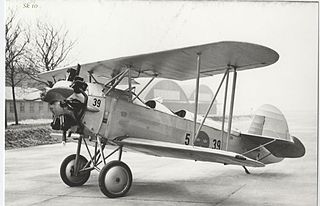Operators
 Estonia
Estonia
 Finland
Finland
 Russia
Russia
 Soviet Union
Soviet Union
| M-16 | |
|---|---|
| General information | |
| Type | Reconnaissance flying boat |
| Manufacturer | Shchetinin |
| Designer | Dmitri Grigorovich |
| Primary users | Russian navy |
| Number built | 40 |
| History | |
| Introduction date | 1916 |
| Retired | 1920s |
| Developed from | Grigorovich M-9 |
Grigorovich M-16 (alternative designation ShCh M-16, sometimes also Shchetinin M-16) was a successful Russian World War I-era biplane flying boat of the Farman type, developed from the M-9 by Grigorovich. Somewhat larger than the M-9, the M-16 was a version especially intended for winter operations, with better aerodynamic qualities.
Six M-16s fell into Finnish hands during the Russian Civil War. The first Finnish parachute jump was made on June 17, 1922 from a M-16 by Eero Erho. The aircraft were flown until 1923. One additional plane was captured by the fledgling Estonian Air Force.
Data from Thulinista Hornetiin – 75 vuotta Suomen ilmavoimien lentokoneita, [1] Grigorovich Flying Boats [2]
General characteristics
Performance
Armament

The Valmet Tuuli was a trainer aircraft, developed for the Finnish Air Force by the State Aircraft Factory. The aircraft was to be produced in 3 different versions. The last version, Tuuli III was redesigned from scratch, and is basically an entirely different aircraft.

Adaridi AD 3 was a wooden aircraft designed by the Russian engineer Boris Adaridin, who lived in Finland. It was a high wing aircraft with a low-powered engine. In 1923, the Finnish Air Force ordered one Adaridi aircraft. The aircraft was not given any official designation code. The maiden flight was on April 17, 1924.

Fokker D.X was a Dutch fighter aircraft designed after World War I.

Friedrichshafen FF.33 was a German single-engined reconnaissance three-bay wing structure biplane, using twin floats, designed by Flugzeugbau Friedrichshafen in 1914 for the Marine-Fliegerabteilung aviation forces of the Kaiserliche Marine.

The Friedrichshafen FF.41a was a large, German-built, three-seat, twin-engine floatplane reconnaissance aircraft designed by Flugzeugbau Friedrichshafen in 1917.

Friedrichshafen FF.49 was a German, two-seat, single-engine float-plane designed by Flugzeugbau Friedrichshafen in 1917.

Georges Levy G.L. 40 HB2 was a three-seated French, amphibious biplane aircraft that was designed in 1917. The aircraft was designed by Blanchard and Le Pen and therefore the aircraft was also known as the Levy-Le Pen. Le Pen was Maurice Jules-Marie Le Pen born in Lorient, Morbihan, France in 1889; he was killed in a car crash in 1919. It was claimed to be the best French amphibious aircraft of World War I, but that is probably due to the low scale production of such aircraft in France at that time.

IVL K.1 Kurki was a prototype for a four-seated, high-wing trainer aircraft, which was designed in 1927 by IVL. The designer was Asser Järvinen and the prototype was manufactured at the IVL plant at Suomenlinna. The aircraft made its maiden flight on March 30, 1927. Only one aircraft was manufactured.

Junkers A 35 was a two-seater cantilever monoplane, used for postal, training and military purposes. The aircraft was designed in the 1920s by Junkers in Germany and manufactured at Dessau and by AB Flygindustri in Limhamn, Sweden and conversions from A 20s were made in Fili, Russia.

The LVG C.VI was a German two-seat reconnaissance and artillery spotting aircraft used during World War I.

Grigorovich M-5 was a successful Russian World War I-era two-bay unequal-span biplane flying boat with a single step hull, designed by Grigorovich. It was the first mass production flying boat built in Russia.

The Grigorovich M-9 was a Russian World War I-era biplane flying boat, developed from the M-5 by Grigorovich.

Grigorovich M-15 was a successful Russian World War I-era biplane flying boat, developed from the M-9 by Grigorovich.

Raab-Katzenstein RK-26 Tigerschwalbe, also known as the Fieseler F 1 Tigerschwalbe, was a German twin-seat biplane trainer aircraft designed by Gerhard Fieseler by the end of the 1920s.
Kurt Volmar Berger (1896–1977) was an aviation engineer and the chief designer at the Finnish aircraft manufacturing company Valtion Lentokonetehtaat.

The Grigorovich M-11 was a Russian single-seat fighter flying boat designed by Dmitry Pavlovich Grigorovich and built by Shchetinin

The Friedrichshafen FF.71 was a German biplane floatplane produced by Flugzeugbau Friedrichshafen.
The Grigorovich MU-2 was a trainer flying boat built in the Soviet Union in the mid-1920s. It was designed by the Grigorovich Design Bureau after the failure of the Grigorovich MUR-1, featuring an all-metal hull. However, it was never put into production due to poor performance and sluggish take-off behavior.
The Grigorovich M-23bis was a Soviet biplane flying boat built during the 1920s.
The Grigorovich ROM-1 was a long-range reconnaissance flying boat designed by the Grigorovich Design Bureau for the Soviet Navy in the late 1920s.